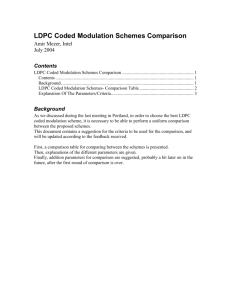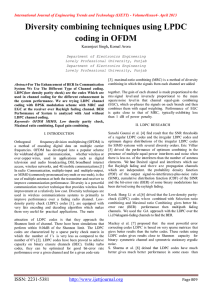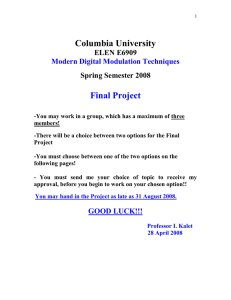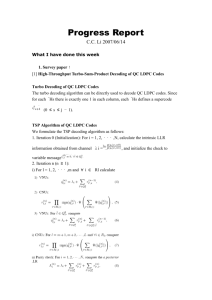Analytical Performance of LDPC Codes with OC in Rekha Rani
advertisement
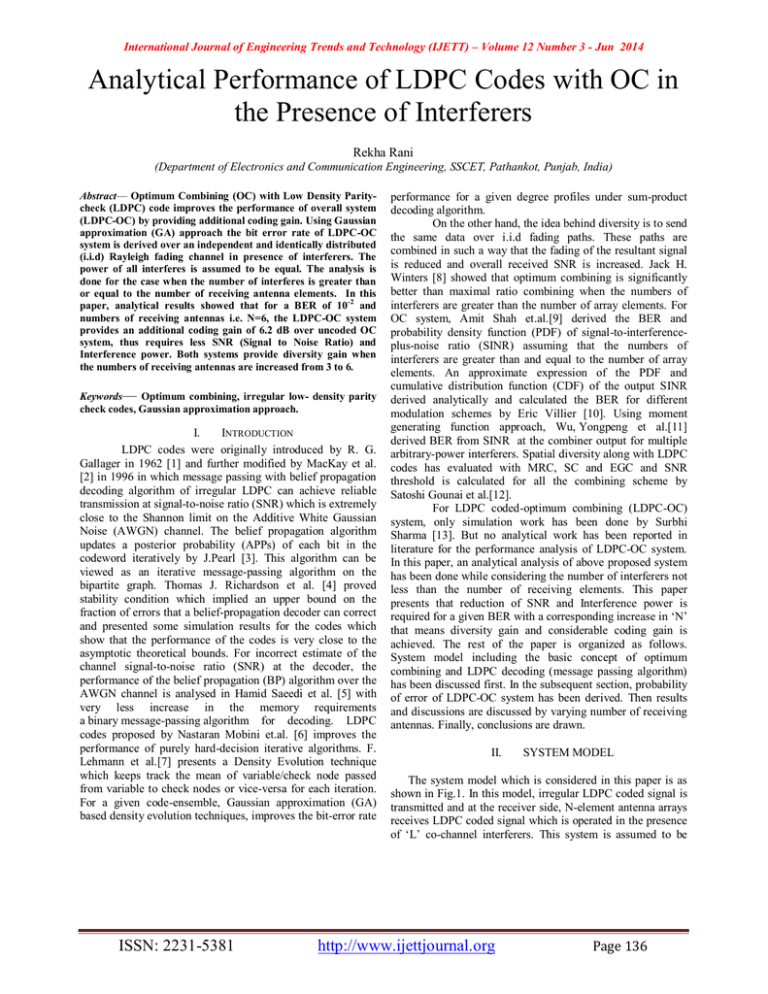
International Journal of Engineering Trends and Technology (IJETT) – Volume 12 Number 3 - Jun 2014 Analytical Performance of LDPC Codes with OC in the Presence of Interferers Rekha Rani (Department of Electronics and Communication Engineering, SSCET, Pathankot, Punjab, India) Abstract— Optimum Combining (OC) with Low Density Paritycheck (LDPC) code improves the performance of overall system (LDPC-OC) by providing additional coding gain. Using Gaussian approximation (GA) approach the bit error rate of LDPC-OC system is derived over an independent and identically distributed (i.i.d) Rayleigh fading channel in presence of interferers. The power of all interferes is assumed to be equal. The analysis is done for the case when the number of interferes is greater than or equal to the number of receiving antenna elements. In this paper, analytical results showed that for a BER of 10-2 and numbers of receiving antennas i.e. N=6, the LDPC-OC system provides an additional coding gain of 6.2 dB over uncoded OC system, thus requires less SNR (Signal to Noise Ratio) and Interference power. Both systems provide diversity gain when the numbers of receiving antennas are increased from 3 to 6. Keywords— Optimum combining, irregular low- density parity check codes, Gaussian approximation approach. I. INTRODUCTION LDPC codes were originally introduced by R. G. Gallager in 1962 [1] and further modified by MacKay et al. [2] in 1996 in which message passing with belief propagation decoding algorithm of irregular LDPC can achieve reliable transmission at signal-to-noise ratio (SNR) which is extremely close to the Shannon limit on the Additive White Gaussian Noise (AWGN) channel. The belief propagation algorithm updates a posterior probability (APPs) of each bit in the codeword iteratively by J.Pearl [3]. This algorithm can be viewed as an iterative message-passing algorithm on the bipartite graph. Thomas J. Richardson et al. [4] proved stability condition which implied an upper bound on the fraction of errors that a belief-propagation decoder can correct and presented some simulation results for the codes which show that the performance of the codes is very close to the asymptotic theoretical bounds. For incorrect estimate of the channel signal-to-noise ratio (SNR) at the decoder, the performance of the belief propagation (BP) algorithm over the AWGN channel is analysed in Hamid Saeedi et al. [5] with very less increase in the memory requirements a binary message-passing algorithm for decoding. LDPC codes proposed by Nastaran Mobini et.al. [6] improves the performance of purely hard-decision iterative algorithms. F. Lehmann et al.[7] presents a Density Evolution technique which keeps track the mean of variable/check node passed from variable to check nodes or vice-versa for each iteration. For a given code-ensemble, Gaussian approximation (GA) based density evolution techniques, improves the bit-error rate ISSN: 2231-5381 performance for a given degree profiles under sum-product decoding algorithm. On the other hand, the idea behind diversity is to send the same data over i.i.d fading paths. These paths are combined in such a way that the fading of the resultant signal is reduced and overall received SNR is increased. Jack H. Winters [8] showed that optimum combining is significantly better than maximal ratio combining when the numbers of interferers are greater than the number of array elements. For OC system, Amit Shah et.al.[9] derived the BER and probability density function (PDF) of signal-to-interferenceplus-noise ratio (SINR) assuming that the numbers of interferers are greater than and equal to the number of array elements. An approximate expression of the PDF and cumulative distribution function (CDF) of the output SINR derived analytically and calculated the BER for different modulation schemes by Eric Villier [10]. Using moment generating function approach, Wu, Yongpeng et al.[11] derived BER from SINR at the combiner output for multiple arbitrary-power interferers. Spatial diversity along with LDPC codes has evaluated with MRC, SC and EGC and SNR threshold is calculated for all the combining scheme by Satoshi Gounai et al.[12]. For LDPC coded-optimum combining (LDPC-OC) system, only simulation work has been done by Surbhi Sharma [13]. But no analytical work has been reported in literature for the performance analysis of LDPC-OC system. In this paper, an analytical analysis of above proposed system has been done while considering the number of interferers not less than the number of receiving elements. This paper presents that reduction of SNR and Interference power is required for a given BER with a corresponding increase in ‘N’ that means diversity gain and considerable coding gain is achieved. The rest of the paper is organized as follows. System model including the basic concept of optimum combining and LDPC decoding (message passing algorithm) has been discussed first. In the subsequent section, probability of error of LDPC-OC system has been derived. Then results and discussions are discussed by varying number of receiving antennas. Finally, conclusions are drawn. II. SYSTEM MODEL The system model which is considered in this paper is as shown in Fig.1. In this model, irregular LDPC coded signal is transmitted and at the receiver side, N-element antenna arrays receives LDPC coded signal which is operated in the presence of ‘L’ co-channel interferers. This system is assumed to be http://www.ijettjournal.org Page 136 International Journal of Engineering Trends and Technology (IJETT) – Volume 12 Number 3 - Jun 2014 interference limited and also degree of freedom of system is insufficient to suppress all the interferers, meaning ≥ N. The system employs binary phase shift keying (BPSK) modulation and channel is characterized by i.i.d flat Rayleigh fading. The optimally combined signal y (t) at the output of optimum combiner is fed to the LDPC decoder which is given as y (t) =a*s (t) + n (t) the variable node messages is negative[4]. The PDF of Log Likelihood Ratio (LLR) of variable nodes, that passes the message to check node on edge ‘e’, is convolution of the PDF of summation of LLR of check node message received on all incoming edges except ‘e’ and PDF of channel LLR. But it is very difficult to update these PDFs at ‘l’ iterations. So in this paper, all the message involved in the decoding process which have a symmetric Gaussian distribution is assumed where only mean value is to be updated iteratively [14]. The conditional PDF of channel LLR over the channel gain ‘a’ is given in [15] p(q|a, s(t) = +1) = √ ⁄ exp − (3) ⁄ Fig 1.System model of OC with LDPC where ‘a’ is a optimum combining channel gain over i.i.d Rayleigh fading, s(t) is transmitted BPSK modulated signal and n(t) is AWGN with mean zero and variance σ .The received signal y(t) is decoded by message passing algorithm based on GA. Idea behind message passing decoding algorithm is to pass messages in a cycle. Each cycle has two phases, in the first phase, messages are passed from variable node ‘v’ of degree ‘j’ to check node ‘c’ of degree ‘i’ of the bipartite graph. In the second phase, messages are passed back from the check node ‘c’ to the variable node ‘v’. The complete description of irregular LDPC codes is specified by the concept of degree distribution pair which is given by [13] λ(x), ρ(x) = ∑ λx ,∑ ρx whered and d are the maximum degree of variable node ‘v’ and check node ‘c’ respectively. The coefficient λ andρ is the fraction of graph branches connected to degree ‘j’ variable nodes and ‘i’ check nodes respectively. λ(x)and ρ(x) are referred as variables and check node degree distribution respectively. III. BER ANALYSIS OF CODED SYSTEM Considering optimum combining diversity, the probability density function of maximum SIR of uncoded system is given by [9] p (γ) = ( ) ( ) ( ) with ∗ 2a ⁄σ , mean variance 4a ⁄σ whereσ = , Riscoderate and ‘q’ is the initial message passed ⁄ from variable node ‘v’ to check node ‘c’. The unconditional PDF of channel LLR is calculated by averaging the equation (3) over the channel gain ‘a’ p (q) = ∫ p(q|a, s(t) = +1) p(a)da(4) where p(a) can be obtained from the PDF of SIR of equation (1) at the combiner by using transformation the PDF of one variable to PDF of other variable [16] ( p(a) = ( ) ( ) ( ) ) (5) Putting the values of equations (3 and 5) in equation (4) and using the integral in [17, equation 3.325], the unconditioned PDF of channel LLR is calculated as p (q) = ( ) √ ( ) ( − (−1) (−1) ) √ exp − √ exp − σ |q| + σ |q| + (6) (1) whereL + 1 ≅ L(overloadedcase)andb = γ ≥ 0, 1 ≤ N ≤ L, The PDF of check node is given by [7] Its probability of bit error considering the given PDF in equation (1) is calculated as below in equation (2). To calculate the BER of LDPC-OC system, the message passing algorithm based on GA can be analyzed with the assumption that the block length of code is infinity and without loss of generality, all zero codeword is sent. So that the BER at iteration ‘l’ is simply the average probability that ISSN: 2231-5381 p (q) = exp − ( ) (7) where m is the mean of check node ‘c’ of degree ‘i’. http://www.ijettjournal.org Page 137 International Journal of Engineering Trends and Technology (IJETT) – Volume 12 Number 3 - Jun 2014 P = ( √ ( ) ( ) ( ) ) . F .Γ − L + 1, L + 1 − N; L − N + , L − N + 2; Γ N+ . F N+ , ;N−L+ , ; At (l+1) th iteration mean of check node ‘c’ is updated by m ∑ = 4 erfc Putting the values of equations (6 and 7) in equation (8) by using the integral in [17, equation 3.322(2)], then PDF of variable node is ( ) ( ) ( (−1) (2) √ ) ∗ (−1) TABLE I PROBABILITY ERROR of UNCODED OC at BER of 10-1 − exp − exp erfc + σ RESULTS AND DISCUSSION In this section, the analytical results for the LDPC-OC system have been presented. To evaluate the performance, system has been considered as overloaded (i.e. when the number of interferers is greater than or equal to the number of receiving antenna elements). The number of receive antennas ‘N’ is taken as 3, 4, 5 and 6 and number of interferers ‘L’ is taken as 18. p (q) = p (q) ⊗ p (q)(8) ) ( ) ( ) ( ) ρ 1 − 1 − 2P IV. √ ( + Because at (l+1)th iteration mean of variable node ‘v’ of degree ‘j’ is m = (j − 1)m which is given by[5]. The PDF of variable node is calculated by convolving the PDF of channel LLR equation (6) with the PDF of check node equation (7) that is p (q) = + Probability of error at BER of 10-1 Number of receiving antenna Signal to Noise ratio(dB) N=3 7.5dB N=4 5.5 dB N=5 4 dB N=6 3 dB σ q + (9) th To obtain the probability of error Pe at l iteration, integrate the PDF of variable node given by equation (9) from -∞ to 0, then bit error rate is P = ( ) ( ) ( √ ) (−1) (−1) − − erf σ √ exp − − exp − + √ erfc (10) Fig.2 BER for uncoded system when receive antenna varies from 3 to 6 For the uncoded system, shown in Fig.2, it is clearly observed that as the numbers of receiving antennas are raised, significant diversity gain is achieved. For BER of 10-1, an improvement of 1 dB is achieved in SNR when number of receive antennas are increased from 5 to 6. Now at (l +1) th iteration, averaging the above equation over all bit node degrees ‘j’ using equation (10) becomes as given below in equation (11). P = ( √ ) ( ) ( ) √ ∑ λ erf σ ISSN: 2231-5381 (−1) ( ) − (−1) − exp − ( √ ) ( exp + ( ) ) erfc( http://www.ijettjournal.org − ( ( ) ) − ) (11) Page 138 International Journal of Engineering Trends and Technology (IJETT) – Volume 12 Number 3 - Jun 2014 V. TABLE II PROBABILITY ERROR of CODED OC (LDPC-OC) at BER of 10-4 CONCLUSION Probability of error at BER of 10-4 when L=18 Number of receiving antenna Signal to Noise ratio(dB) N=3 10 dB N=4 8 dB N=5 6.5 dB N=6 5.5 dB Using the Gaussian approximation approach, the BER expression for uncoded OC and irregular LDPC-OC over an i.i.d rayleigh fading channel has been derived. From the numerical results, it is shown that in the presence of ‘L’ interferers with equal power, the LDPC-optimum combiner gives the more optimistic results as compared to uncoded-OC system. Fig. 3 presents the result for LDPC-OC system obtained using equation (11). For the LDPC-OC system, at the BER of 10 -4, an improvement of 1 dB is achieved in SNR when number of receive antenna is varying from 5 to 6. REFERENCES [1] [2] [3] [4] [5] [6] Fig.3 BER for coded OC system when receive antenna varies from 3 to 6 TABLE III COMPARISONS BETWEEN PROBABILITY ERROR of uncoded OC and -2 LDPC-OC at BER of 10 [7] [8] [9] Probability of Error at BER of 10-2 and L=18 Combining Techniques Signal to Noise ratio(dB) OC,N=5 10 dB LDPC-OC,N=5 3.2 dB OC,N=6 9 dB LDPC-OC,N=6 2.8 dB Comparison of uncoded and LDPC-OC system is given in Fig.4. It is clear from the figure that significant coding gain is achieved when comparing both the systems. At BER of 10-2, a coding gain of 6.2 dB is achieved by LDPC-OC system over OC system alone when the number of receive antenna is 6. [10] [11] [12] [13] [14] [15] [16] [17] R. G. Gallager, “Low-Density Parity-Check Codes”, IRE transactions on information theory, vol. 21,pp. 21-28, Jan.1962. David J. C. MacKay, “Comparison of Constructions of Irregular Gallager Codes”, IEEE Transactions on Communication, vol.47, pp.1449-1454,Oct.1999. J.Pearl, Probabilistic Reasoning in Intelligent Systems Networks of Plausible Inference, 2nd ed.,San Francisco, Califomia, 1988. Thomas J. Richardson, M. Amin Shokrollahi, “Design of Capacity-Approaching Irregular Low-Density Parity-Check Codes”, IEEE transactions on information theory, vol.47,pp. 619637, Feb.2001. Hamid Saeedi and Amir H. Banihashemi, “Performance of Belief Propagation for Decoding LDPC Codes in the Presence of Channel Estimation Error”, IEEE Transactions on Communications, vol.55,pp. 83-89, Jan.2007. Nastaran Mobini, A.H. Banihashemi, S. Hemati, “ A Differential Binary Message-Passing LDPC Decoder”, IEEE Transactions On Communications, vol.57, pp.2518-2523,Sept. 2009. F. Lehmann and G. M. Maggio, “Analysis of the iterative decoding of LDPC and product codes using the Gaussian approximation”, IEEE Trans. Inform. Theory, vol.49,pp. 2993-3000, Nov.2003. Jack H. Winters, “Optimum Combining in Digital Mobile Radio with Co -channel Interference”, IEEE journal on selected areas in communication, vol. 2, pp. 528-539, Aug.1984. Amit Shah, Alexander M. Haimovich, “Performance Analysis of Optimum Combining in Wireless Communications with Rayleigh Fading and co channel Interference”, IEEE transactions on communications, vol.46, pp. 473-479, Apr.1998. Eric Villier, “Performance Analysis of Optimum Combining with Multiple Interferers in Flat Rayleigh Fading”, IEEE Communication Letters, vol.47, pp.503-1510, Oct.1999. Yongpeng Wu, Lv Ding, Jiee Chen, Xiqi Gao, “New Performance Results for Optimum Combining in Presence of Arbitrary-Power Interferers and Thermal Noise”, IEICE Transactions on Communications, , vol. E93-B, pp.1919-1922, Jul.2010. Satoshi Gounai and Tomoaki Ohtsuki, “Performance Analysis of LDPC Code with Spatial Diversity”, on Proc. IEEE Vehicular Technology, 2006, p. 5. Surbhi Sharma and rkhanna, “Analysis of LDPC with optimum combining”, international journal of electronics, vol.96, pp. 803811, Aug.2009. S. T. Brink, “Convergence behavior of iteratively decoded parallel concatenated codes”, IEEE Trans. Commun.,vol. 49,pp. 17271737, Oct.2001. J. Hou, Paul H. Siegel, Laurence B. Milstein, “Performance analysis and code optimization of low density parity-check codes on Rayleigh fading Channels”, IEEE J. Select. Areas Commun., vol. 19,pp. 924-934, May 2001. Athanasios Papouli, Probability, random variables and stochastic processes, 4th ed.,Tata McGraw-Hill, 2002. S. Gradshteyn and I. M. Ryzhik, Tables of Integrals, Series and Products, New York, 2007. Fig.4 Comparison between BER of coded and uncoded system when receive antenna varies from 5 to 6 ISSN: 2231-5381 http://www.ijettjournal.org Page 140
